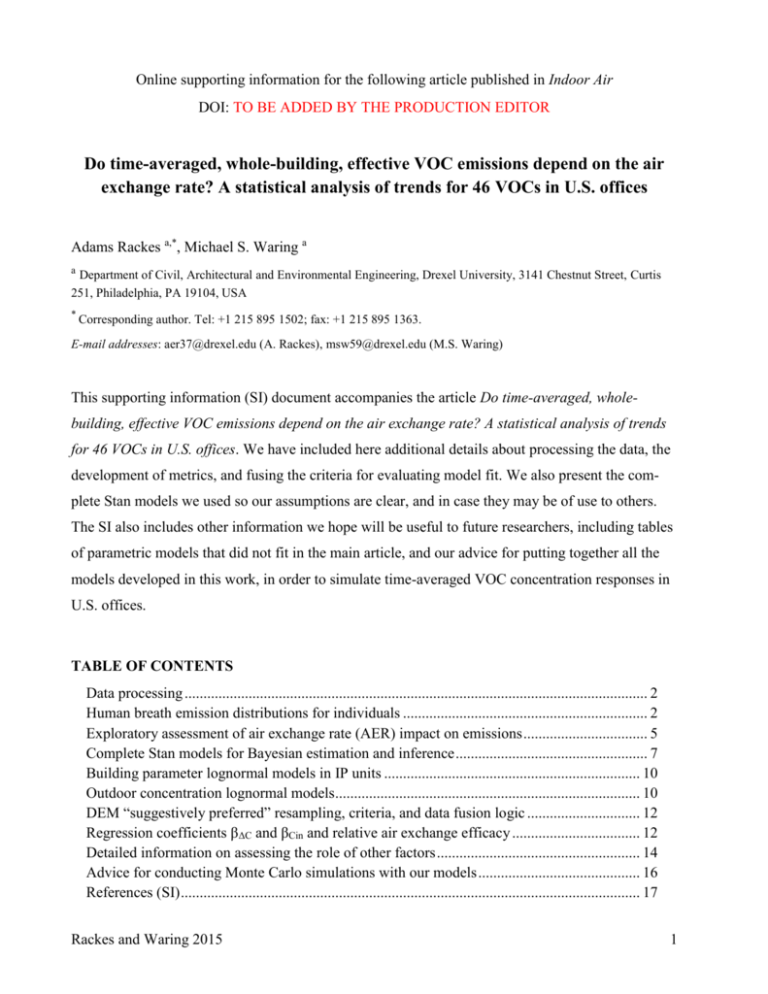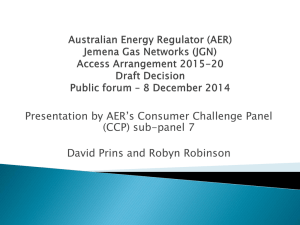Outdoor concentration lognormal models
advertisement

Online supporting information for the following article published in Indoor Air
DOI: TO BE ADDED BY THE PRODUCTION EDITOR
Do time-averaged, whole-building, effective VOC emissions depend on the air
exchange rate? A statistical analysis of trends for 46 VOCs in U.S. offices
Adams Rackes a,*, Michael S. Waring a
a
Department of Civil, Architectural and Environmental Engineering, Drexel University, 3141 Chestnut Street, Curtis
251, Philadelphia, PA 19104, USA
*
Corresponding author. Tel: +1 215 895 1502; fax: +1 215 895 1363.
E-mail addresses: aer37@drexel.edu (A. Rackes), msw59@drexel.edu (M.S. Waring)
This supporting information (SI) document accompanies the article Do time-averaged, wholebuilding, effective VOC emissions depend on the air exchange rate? A statistical analysis of trends
for 46 VOCs in U.S. offices. We have included here additional details about processing the data, the
development of metrics, and fusing the criteria for evaluating model fit. We also present the complete Stan models we used so our assumptions are clear, and in case they may be of use to others.
The SI also includes other information we hope will be useful to future researchers, including tables
of parametric models that did not fit in the main article, and our advice for putting together all the
models developed in this work, in order to simulate time-averaged VOC concentration responses in
U.S. offices.
TABLE OF CONTENTS
Data processing ........................................................................................................................... 2
Human breath emission distributions for individuals ................................................................. 2
Exploratory assessment of air exchange rate (AER) impact on emissions ................................. 5
Complete Stan models for Bayesian estimation and inference ................................................... 7
Building parameter lognormal models in IP units .................................................................... 10
Outdoor concentration lognormal models................................................................................. 10
DEM “suggestively preferred” resampling, criteria, and data fusion logic .............................. 12
Regression coefficients βΔC and βCin and relative air exchange efficacy .................................. 12
Detailed information on assessing the role of other factors ...................................................... 14
Advice for conducting Monte Carlo simulations with our models ........................................... 16
References (SI) .......................................................................................................................... 17
Rackes and Waring 2015
1
Data processing
During the BASE study, three methods were used to measure VOCs, each sampling for ~8 to 10
hours. In coordinating data, we used only VOC concentrations measured with the EPA preferred
method for each compound, even when concentrations obtained by other methods were available.
(For a detailed account of the study protocol and measurement methods, see U.S. EPA (2003).) For
each VOC measurement, the BASE study reported either a real value or codes indicating that the
concentration was either below the limit of quantification (LOQ), below the limit of detection
(LOD), or an error or missing measurement. We replaced entries below the LOQ or LOD with half
the value of the respective threshold for that VOC (Hornung and Reed, 1990). Any duplicate samples were averaged with the primary sample values. After removing a small number of extreme outliers, we used the outdoor concentration directly and the average of the three indoor readings for the
indoor concentration. We discarded any measurements where either the indoor or outdoor concentration was missing, since both are needed to apply Equation 1.
Ventilation measurements were also taken in each building, and subsequently analyzed by National Institute of Standards and Technology (NIST), whose final report contains detailed descriptions of procedures and findings (Persily and Gorfain, 2008). Multiple measurements were taken,
usually with separate morning and afternoon readings on consecutive days. We coordinated each
primary ventilation measurement (averaging multiple measurements) with its associated VOC sampling period, and we also recorded the estimate uncertainty. We excluded one building for which the
report did not provide any ventilation measurements.
In subsequent model fitting, we added the effect of infiltration to the ventilation measurements,
as described in the article. We did not apply this adjustment to the 14 buildings in the BASE study
where CO2 tracer gas decay tests were used to derive total outdoor air flow rates.
Human breath emission distributions for individuals
We developed our per-occupant emissions estimates from literature, restricting our scope to human breath emissions as discussed in the paper body. VOCs have been measured in human breath,
either via exhalation into a tube or sampling near the mouth and subtracting background concentration (Fenske and Paulson, 1999; Moser et al., 2005; Riess et al., 2010; Smith et al., 2007; Wallace et
al., 1991). Most studies report point estimates, but two (Riess et al., 2010; Wallace et al., 1991) gave
enough information for some VOCs to develop lognormal distributions for breath concentration. To
combine VOC estimates from multiple studies, we used this method: If only point estimates were
available, their values were averaged. If one distribution was available, we used it directly, and any
other point estimates were ignored. If two distributions were available, their parameters were combined geometrically, weighted by the number of samples, and again any point estimates were ignored.
Rackes and Waring 2015
2
VOC breath concentrations were converted to emissions by assuming atmospheric pressure, a
breath temperature of 35.6 °C (Carpenter and Buttram, 1998), and a breathing rate of 0.78 m3/h, typical for sedentary activity (U.S. EPA, 2011). This procedure yielded breath concentration distributions for 18 VOCs and point estimates for 23 more, for a total of 41 VOCs, of which 26 were measured in the BASE study. The final estimates are listed in Table SI-1 for VOCs measured in the
BASE study and Table SI-2 for VOCs not in BASE. It is worth emphasizing that the distributions in
Tables SI-1 and SI-2 are for individuals. The average breath emissions term in Equation 1, Ep,ij,
does not follow the individual distribution since it is the average of emissions from many (typically
at least 50) occupants, each of which is a lognormal random variable.
Rackes and Waring 2015
3
Table SI-1 Human breath emissions for compounds included in the BASE study
Human breath emissions
Classification
Alcohol
Alcohol
Alcohol
Alcohol
Alcohol
Alkane
Alkane
Alkane
Alkane
Alkane
Alkane
Alkane
Alkene
Alkene
Aromatic
Aromatic
Aromatic
Aromatic
Aromatic
Aromatic
Aromatic
Aromatic
Aromatic
Aromatic
Aromatic
Aromatic
Aromatic
Aromatic
Aromatic
Aromatic
Carbonyl
Carbonyl
Carbonyl
Carbonyl
Carbonyl
Carbonyl
Carbonyl
Carbonyl
Carbonyl
Ester
Ester
Ester
Ester
Ether
Ether
Halocarbon
Halocarbon
Halocarbon
Halocarbon
Halocarbon
Halocarbon
Halocarbon
Halocarbon
Halocarbon
Halocarbon
Halocarbon
Halocarbon
Rackes
and
Halocarbon
Organosulfur
Organosulfur
Compound
1-butanol
2-ethyl-1-hexanol
2-methyl-1-propanol
2-propanol
ethanol
3-methyl pentane
decane
dodecane
hexane
octane
nonane
undecane
a-pinene
d-limonene
1,2,4-trichlorobenzene
1,2,4-trimethylbenzene
1,2-dichlorobenzene
1,3,5-trimethylbenzene
1,4-dichlorobenzene
4-ethyltoluene
4-phenylcyclohexene
benzene
chlorobenzene
ethylbenzene
m & p-xylenes
naphthalene
o-xylene
phenol
styrene
toluene
2-butanone (MEK)
4-methyl-2-pentanone
acetaldehyde
acetone
formaldehyde
hexanal
heptanal
nonanal
pentanal
2,2,4-trimethyl-1,3-pentanediol diisobutyrate
2,2,4-trimethyl-1,3-pentanediol monoisobutyrate
butyl acetate
ethyl acetate
2-butoxyethanol
t-butyl methyl ether
1,1,1-trichloroethane
1,2-dichloroethane
bromomethane
carbon tetrachloride
chloroethane
chloroform
chloromethane
dichlorodifluoromethane
methylene chloride
tetrachloroethene
trichloroethene
Waringtrichlorofluoromethane
2015
trichlorotrifluoroethane
carbon disulfide
dimethyl disulfide
CAS
71-36-3
104-76-7
78-83-1
67-63-0
64-17-5
96-14-0
124-18-5
112-40-3
110-54-3
111-65-9
111-84-2
1120-21-4
80-56-8
5989-27-5
120-82-1
95-63-6
95-50-1
108-67-8
106-46-7
622-96-8
4994-16-5
71-43-2
108-90-7
100-41-4
1330-20-7
91-20-3
95-47-6
108-95-2
100-42-5
108-88-3
78-93-3
108-10-1
75-07-0
67-64-1
50-00-0
66-25-1
111-71-7
124-19-6
110-62-3
6846-50-0
25265-77-4
123-86-4
141-78-6
111-76-2
1634-04-4
71-55-6
107-06-2
74-83-9
56-23-5
75-00-3
67-66-3
74-87-3
75-71-8
75-09-2
127-18-4
79-01-6
75-69-4
76-13-1
75-15-0
624-92-0
GM
(µg/h/occ)
285.00
159.00
0.24
0.10
0.67
0.41
0.46
0.48
12.30
0.46
3.78
0.32
6.70
2.23
18.10
0.10
31.80
29.00
51.52
725.90
3.94
34.00
46.00
2.16
0.27
2.67
-
GSD
(-)
3.24
1.90
1.75
1.75
1.99
1.98
1.50
1.68
1.85
-
Sources
1,3
3
5
5
5
5
5
5
5
5
2
5
2,5
2,5
2
5
2
1
2,4
3,4
2
1
1
5
5
5
-
4
Carbonyl
pentanal
110-62-3
Ester
2,2,4-trimethyl-1,3-pentanediol diisobutyrate
6846-50-0
Ester
2,2,4-trimethyl-1,3-pentanediol monoisobutyrate 25265-77-4
Ester
butyl acetate
123-86-4
Ester
ethyl acetate
141-78-6
Ether
2-butoxyethanol
111-76-2
Table SI-1 (cont.) Human breath emissions for compounds included in the BASE
study
Ether
t-butyl methyl ether
1634-04-4
Halocarbon
1,1,1-trichloroethane
71-55-6
Halocarbon
1,2-dichloroethane
107-06-2
Halocarbon
bromomethane
74-83-9
Halocarbon
carbon tetrachloride
56-23-5
Halocarbon
chloroethane
75-00-3
Halocarbon
chloroform
67-66-3
Halocarbon
chloromethane
74-87-3
Halocarbon
dichlorodifluoromethane
75-71-8
Halocarbon
methylene chloride
75-09-2
Halocarbon
tetrachloroethene
127-18-4
Halocarbon
trichloroethene
79-01-6
Halocarbon
trichlorofluoromethane
75-69-4
Halocarbon
trichlorotrifluoroethane
76-13-1
Organosulfur
carbon disulfide
75-15-0
Organosulfur
dimethyl disulfide
624-92-0
Sources:
1 - Fenske and Paulson, 1999
2 - Moser et al., 2004
3 - Smith et al., 2007
4 - Riess et al., 2010
5 - Wallace et al., 1991
46.00
2.16
0.27
2.67
-
-
1
5
5
5
-
Table SI-2 Human breath emissions for additional compounds not included in the BASE study. These compounds are included for
reference only.
Human breath emissions
Classification
Compound
Not included in BASE dataset
Alcohol
Methanol
Alkane
Isopentane
Alkane
Pentane
Alkene
Butene
Alkene
Ethylene
Alkene
Isoprene
Aromatic
Furan
Carbonyl
2,6-Di-tert-Butyl-p-Benzoquinone
Carboxylic acid
Acetic Acid
Carboxylic acid
Formic acid
Inorganic
Ammonia
Inorganic
Hydrogen Sulfide
Inorganic
Nitric Oxide
Nitrile
Acetonitrile
Organosulfur
Dimethyl Sulfide
Sources:
1 - Fenske and Paulson, 1999
2 - Moser et al., 2004
3 - Smith et al., 2007
4 - Riess et al., 2010
5 - Wallace et al., 1991
CAS
GM
(µg/h/occ)
GSD
(-)
Sources
67-56-1
78-78-4
109-66-0
106-98-9
74-85-1
78-79-5
110-00-9
719-22-2
64-19-7
64-18-6
7664-41-7
7783-06-4
10102-43-9
75-05-8
78-18-3
178.80
0.73
27.00
126.00
20.00
114.80
29.00
4.14
113.90
49.12
437.00
0.40
23.22
11.49
20.75
1.82
1.79
1.81
1.96
1.62
2.23
1.36
1.80
1.90
2,3,4
1
1
1
1
2,3
1
1
2
2
3
2
4
2
2
Exploratory assessment of air exchange rate (AER) impact on emissions
Rackes and Waring 2015
5
For an exploratory assessment of the influence of the AER on effective emissions, we divided
the emissions rates calculated according to Equation 2 into three bins according to the associated
AER. The bins—less than 0.5 h-1, between 0.5 h-1 and 3 h-1, and above 3 h-1—approximately correspond to the lower 25% of AERs, the interquartile range of AERs, and the upper 25% of AERs, respectively. We fit a lognormal model to the data in each bin. If the effective emissions were independent of the AER, one would expect the three distributions to look similar.
Figure SI-1 shows the probability densities of the lognormal models in the three bins for six
VOCs: d-limonene, formaldehyde, acetaldehyde, decane, toluene, and butanol. We use these compounds to illustrate results, since they represent a range of associations between emissions and air
exchange. For all these VOCs, the plots show that buildings with higher AERs had emission rates
that were both higher on average and much more variable. Conversely, buildings with lower air exchange had both lower emissions and much tighter distributions.
Fig. SI-1 Lognormal density estimates of effective emission rates in three AER ranges. The labeled points are distribution medians
Figure SI-1 indicates that the impact of AER on the effective emissions distribution is most pronounced in the upper AER bin, which has a very large spread for all the VOCs depicted. At least
part of this spread is a result of back-calculating emissions and may not reflect a real phenomenon.
This is because, when inferring effective emissions from the measured quantities, Ez is proportional
to the measured AER (per Equation 2), and larger AERs in the BASE study were generally subject
to larger measurement uncertainties. If we compare the distribution modes, which are less affected
by variability inflation, we would probably conclude from Figure 1 that there appear to be systematic and consistent increases in effective emissions with increasing AER for d-limonene, formaldehyde, and acetaldehyde. For decane and tolune, the relation is more subtle but potentially present,
and could easily merely be an artifact of amplified measurement uncertainty for butanol.
Rackes and Waring 2015
6
This screening exercise shows that there is good reason to doubt whether emissions are in fact
independent of air exchange, and does so without making any assumptions about the nature of the
relation between Ez and λ. In addition, this model-free assessment does not allow us to generalize
discrete findings to estimate a presumably continuous impact, and also sacrifices statistical power
by treating data in each bin in isolation. Therefore, a more sophisticated treatment of measurement
uncertainty is clearly needed before drawing any conclusions. Bayesian estimation, as discussed in
the main article, provides this treatment.
Complete Stan models for Bayesian estimation and inference
AER model
data {
int<lower=0> N;
// number of buildings
vector[N] Qvent_meas;
// measured ventilation in L/s-m2
vector[N] Qunc;
// uncertainty in ventilation measurement, L/s-m2
vector[N] h_meas;
// measured ceiling height, m
real aer_inf_mu;
// log infiltration GM
real aer_inf_sigma;
// log infiltration GSD
}
parameters {
vector<lower=0>[N] Qvent;
// true ventilation in L/s-m2
vector<lower=0>[N] aer_inf;
// true infiltration AER, h-1
real aer_tot_mu;
// mu parameter of AER distribution
real<lower=0> aer_tot_sigma;
// sigma parameter of AER distribution
}
transformed parameters {
vector<lower=0>[N] aer_vent;
// true ventilation AER, h-1
vector<lower=0>[N] aer_tot;
// true total AER, h-1
for (n in 1:N)
aer_vent[n] <- 3.6 * Qvent[n] / h_meas[n];
// convert from L/s-m2 to h-1
aer_tot <- aer_vent + aer_inf;
}
model {
Qvent_meas ~ normal(Qvent,Qunc);
// measurement model
aer_inf ~ lognormal(aer_inf_mu, aer_inf_sigma);
// infiltration model
aer_tot ~ lognormal(aer_tot_mu, aer_tot_sigma);
// total AER model
}
Description of sampling for posterior replications
We describe the process of sampling to compute replications in more detail. For the IEM, the
routine did the following Ni times (one for each building): randomly sampled from the lognormal
distribution for Ez,ij, used the governing equation (Equation 7) to calculate Cin,ij given the estimated
true values of Cout,ij, λj, Ep,ij, Pz,j, Az,j, and Vz,j, and applied the measurement equations for Cin,ij and λj
to give simulated measurements. The distribution parameters µEz,i and σEz,i and all true values of latent variables were those proposed by the MCMC sampling on a given iteration. The procedure was
equivalent for the DEM. In the code that follows, posterior replications are created in the “generated
quantities” block, where the suffix “_rng” stands for random number generator.
IEM
Rackes and Waring 2015
7
data {
int<lower=0> N;
real<lower=0> C_mn_spike_pct;
// mean percent of spike recovered
real<lower=0> C_sd_spike_pct;
// SD percent of spike recovered
vector[N] Cin_meas;
vector[N] Cout_meas;
vector<lower=0>[N] Pz;
// assumed perfectly measured
real<lower=0> Ep_mu;
// literature estimate of Ep normal per occ distribution
mean
real<lower=0> Ep_sigma;
// literature estimate of Ep normal distribution sd
vector<lower=0>[N] Az;
// zone area
vector<lower=0>[N] Vz;
// zone volume
vector<lower=0>[N] AER_meas;
// vector of AER measurements, h-1
vector<lower=0>[N] AER_meas_unc;
// vector of AER measurement uncertainties, h-1
}
parameters {
vector<lower=0>[N] Cout;
// Cout in ug/m3 in each building zone
vector<lower=0>[N] Ep_ave;
// Average Ep in ug/h-occ in each building zone
vector<lower=0>[N] Ez;
// Ez in ug/h-m2 in each building zone
vector<lower=0>[N] AER;
// AER in h-1 in each building zone
real Ez_mu;
// log of Ez GM
real<lower=0> Ez_sigma;
// log of Ez GSD
}
transformed parameters {
vector<lower=0>[N] Cin;
vector<lower=0>[N] S;
for (n in 1:N) {
S[n] <- AER[n]*Cout[n] + Ep_ave[n]*Pz[n]/Vz[n];
Cin[n] <- (S[n] + Ez[n]*Az[n]/Vz[n])/AER[n];
}
}
model {
Cout_meas ~ normal(Cout*C_mn_spike_pct, Cout*C_sd_spike_pct);
// Cin measurement model
Cin_meas ~ normal(Cin*C_mn_spike_pct, Cin*C_sd_spike_pct);
// Cout measurement model
AER_meas ~ normal(AER, AER_meas_unc);
// AER measurement model
for (n in 1:N) {
Ep_ave[n] ~ normal(Ep_mu, Ep_sigma/sqrt(Pz[n])); // Ep model, var. inv. prop. to # occ.
}
AER ~ lognormal(log(1.129337), log(2.589431));
// sector-wide AER distribution
Ez ~ lognormal(Ez_mu,Ez_sigma);
// Ez model
}
generated quantities {
vector<lower=0>[N] Ez_pred;
vector<lower=0>[N] Cin_meas_prct_error;
vector<lower=0>[N] Cin_meas_pred;
vector[N] AER_meas_pred;
for (n in 1:N) {
Ez_pred[n] <- lognormal_rng(Ez_mu,Ez_sigma);
Cin_meas_prct_error[n] <- normal_rng(C_mn_spike_pct,C_sd_spike_pct);
Cin_meas_pred[n] <- Cin_meas_prct_error[n]*((S[n] + Ez_pred[n]*Az[n]/Vz[n])/AER[n]);
AER_meas_pred[n] <- 0;
while (AER_meas_pred[n] <= 0)
AER_meas_pred[n] <- normal_rng(AER[n],AER_meas_unc[n]);
}
}
Rackes and Waring 2015
8
DEM
data {
int<lower=0> N;
real<lower=0> C_mn_spike_pct;
// mean percent of spike recovered
real<lower=0> C_sd_spike_pct;
// SD percent of spike recovered
vector[N] Cin_meas;
vector[N] Cout_meas;
vector<lower=0>[N] Pz;
// assumed perfectly measured
real<lower=0> Ep_mu;
// literature estimate of Ep normal distribution mean
real<lower=0> Ep_sigma;
// literature estimate of Ep normal distribution sd
vector<lower=0>[N] Az;
// zone area
vector<lower=0>[N] Vz;
// zone volume
vector<lower=0>[N] AER_meas;
// vector of AER measurements, h-1
vector<lower=0>[N] AER_meas_unc;
// vector of AER measurement uncertainties, h-1
real kL_priorGM;
// prior distribution from bootstrapped curve fits
real kL_priorGSD;
// prior distribution from bootstrapped curve fits
}
parameters {
vector<lower=0>[N] Cout;
// Cout in ug/m3 in each building zone
vector<lower=0>[N] Ep_ave;
// Average Ep in ug/h-occ in each building zone
vector<lower=0>[N] AER;
// AER in h-1 in each building zone
real<lower=0.000001,upper=100> kL;
// air/boundary layer coupling time constant h-1
vector<lower=0,upper=10000>[N] Ceq;
// boundary layer concentrations
real<lower=0> Ceq_mu;
// boundary layer concentration, log(GM)
real<lower=0,upper=log(3)> Ceq_sigma;
// boundary layer concentration, log(GSD)
}
transformed parameters {
vector<lower=0>[N] Cin;
vector<lower=0>[N] S;
for (n in 1:N) {
S[n] <- AER[n]*Cout[n] + Ep_ave[n]*Pz[n]/Vz[n];
Cin[n] <- (S[n] + kL*Ceq[n])/(AER[n] + kL);
}
}
model {
Cout_meas ~ normal(Cout*C_mn_spike_pct, Cout*C_sd_spike_pct);
// Cin measurement model
Cin_meas ~ normal(Cin*C_mn_spike_pct, Cin*C_sd_spike_pct);
// Cout measurement model
AER_meas ~ normal(AER, AER_meas_unc);
// AER measurement model
for (n in 1:N) {
Ep_ave[n] ~ normal(Ep_mu, Ep_sigma/sqrt(Pz[n])); // Ep model, var. inv. prop. to # occ.
}
AER ~ lognormal(log(1.129337), log(2.589431));
// sector-wide AER distribution
Ceq ~ lognormal(Ceq_mu,Ceq_sigma);
// Ceq distribution
kL ~ lognormal(log(kL_priorGM),log(kL_priorGSD)) T[0.000001,100]; // kL prior
}
generated quantities {
vector<lower=0>[N] Ceq_pred;
vector<lower=0>[N] Cin_meas_prct_error;
vector<lower=0>[N] Cin_meas_pred;
vector[N] AER_meas_pred;
for (n in 1:N) {
Ceq_pred[n] <- lognormal_rng(Ceq_mu,Ceq_sigma);
Cin_meas_prct_error[n] <- normal_rng(C_mn_spike_pct,C_sd_spike_pct);
Cin_meas_pred[n] <- Cin_meas_prct_error[n]*((S[n] + kL*Ceq_pred[n])/(AER[n] + kL));
AER_meas_pred[n] <- 0;
while (AER_meas_pred[n] <= 0)
AER_meas_pred[n] <- normal_rng(AER[n],AER_meas_unc[n]);
}
}
Rackes and Waring 2015
9
Building parameter lognormal models in IP units
Table SI-3 Building parameter lognormal models, in IP units
Estimation
method
GM
GSD
Acceptable fit?
(KS test p-value)
h -1
Bayes
1.13
2.59
Yes (0.35)
h -1
MLE
1.21
2.71
Yes (0.40)
3
Building parameter
Units
Air exchange rate, λ
Air exchange rate, λ
Outdoor airflow per occupant
MLE
70.3
2.71
Yes (0.81)
Outdoor airflow per floor area ft 3/min/ft 2
ft /min/occ
MLE
0.24
2.67
Yes (0.41)
Area served by system, A z
ft 2
MLE
15202
1.49
Yes (0.82)
Suspended ceiling height
ft
MLE
8.87
1.08
No (0.00)
Total ceiling height, hz
ft
MLE
12.04
1.12
Yes (0.41)
Occupants per system, Pz
occ
MLE
52.69
1.39
Yes (0.67)
Occupant density, P z /A z
occ/ft 2
MLE
0
1.44
Yes (0.93)
Outdoor concentration lognormal models
See next page.
Rackes and Waring 2015
10
Table SI-4 Outdoor concentration data information and lognormal model parameters and goodness-of-fit test results
Compound
Alcohols
1-butanol
2-ethyl-1-hexanol
2-methyl-1-propanol
2-propanol
ethanol
Alkanes
3-methyl pentane
decane
dodecane
hexane
octane
nonane
undecane
Alkenes
a-pinene
d-limonene
Aromatics
1,2,4-trichlorobenzene
1,2,4-trimethylbenzene
1,2-dichlorobenzene
1,3,5-trimethylbenzene
1,4-dichlorobenzene
4-ethyltoluene
4-phenylcyclohexene
benzene
chlorobenzene
ethylbenzene
m & p-xylenes
naphthalene
o-xylene
phenol
styrene
toluene
Carbonyls
2-butanone (MEK)
4-methyl-2-pentanone
acetaldehyde
acetone
formaldehyde
hexanal
heptanal
nonanal
pentanal
Esters
2,2,4-trimethyl-1,3-pentanediol
diisobutyrate
2,2,4-trimethyl-1,3-pentanediol
monoisobutyrate
butyl acetate
ethyl acetate
Ethers
2-butoxyethanol
t-butyl methyl ether
Halocarbons
1,1,1-trichloroethane
1,2-dichloroethane
bromomethane
carbon tetrachloride
chloroethane
chloroform
chloromethane
dichlorodifluoromethane
methylene chloride
tetrachloroethene
trichloroethene
trichlorofluoromethane
trichlorotrifluoroethane
Organosulfurs
carbon disulfide
dimethyl disulfide
N
N > LOQ
LOQ
(µg/m 3 )
Ez
model?
GM
(µg/m 3 )
GSD
(-)
p-value,
χ 2 test
Result,
χ2 test
32
33
13
13
13
1
0
0
6
13
0.66
0.33
1.70
4.70
2.50
Yes
Yes
Yes
0.16
0.05
3.18
25.22
2.03
1.45
3.69
2.12
0.87
0.06
0.89
0.79
0
0
0
0
59
63
61
33
60
61
61
22
41
21
29
26
29
32
1.31
0.35
0.53
0.66
0.35
0.35
0.35
Yes
Yes
Yes
Yes
Yes
Yes
Yes
0.83
0.48
0.27
1.40
0.27
0.30
0.37
2.58
2.65
2.71
2.82
2.88
2.58
2.45
0.67
0.49
0.26
0.15
0.50
0.11
0.55
0
0
0
0
0
0
0
61
61
8
16
0.35
0.35
Yes
Yes
0.11
0.19
2.69
2.98
0.62
0.68
0
0
26
65
59
62
61
61
33
66
60
64
66
62
66
39
63
66
0
53
0
23
11
35
0
64
0
49
63
18
54
32
20
63
0.71
0.35
0.35
0.35
0.35
0.35
0.33
0.35
0.35
0.35
0.35
0.35
0.35
0.33
0.35
0.35
Yes
Yes
Yes
Yes
Yes
Yes
Yes
Yes
Yes
Yes
Yes
Yes
0.12
0.88
0.06
0.26
0.14
0.39
2.61
0.07
0.68
2.25
0.21
0.83
0.99
0.26
3.41
1.60
2.73
1.23
2.76
3.40
2.68
1.84
1.73
2.50
2.92
2.59
2.76
2.88
2.49
2.47
0.06
0.41
0.00
0.92
0.59
0.43
0.30
0.00
0.94
0.92
0.09
0.69
0.80
0.93
0.69
0
0
1
0
0
0
0
1
0
0
0
0
0
0
0
62
61
85
65
98
35
13
37
32
53
10
84
65
95
18
2
30
5
0.61
0.35
0.49
1.73
0.39
0.66
2.50
0.66
0.66
Yes
Yes
Yes
Yes
Yes
Yes
Yes
Yes
1.24
0.14
2.61
7.72
2.70
0.57
0.65
1.04
0.22
2.09
2.68
2.14
1.66
2.74
2.18
4.07
1.63
2.50
0.01
0.20
0.89
0.65
0.12
0.12
0.83
0.70
0.54
1
0
0
0
0
0
0
0
0
33
0
0.33
Yes
0.05
1.32
0.06
0
33
61
63
2
18
22
0.66
0.35
0.35
Yes
Yes
Yes
0.14
0.18
0.25
2.10
3.05
2.89
0.53
0.66
0.34
0
0
0
33
58
6
10
0.66
1.69
Yes
-
0.20
0.54
2.51
3.88
0.37
0.20
0
0
60
85
85
58
85
85
86
85
98
62
58
97
85
35
1
4
0
3
4
86
78
40
41
10
18
1
0.69
1.00
1.50
1.73
1.50
0.70
1.00
1.80
2.40
0.35
0.35
3.50
2.80
Yes
Yes
Yes
Yes
Yes
Yes
Yes
Yes
0.72
0.15
0.25
0.37
0.25
0.13
2.50
3.92
1.44
0.58
0.11
1.35
0.48
2.10
1.27
1.76
1.74
1.64
2.26
1.40
2.41
3.29
3.37
2.79
2.57
1.55
0.03
0.70
0.93
0.00
0.00
0.00
0.53
0.00
0.22
0.81
0.60
0.00
0.54
1
0
0
1
1
1
0
1
0
0
0
1
0
86
85
43
8
1.30
3.80
Yes
-
0.87
0.78
4.46
2.40
0.52
0.00
0
1
Rackes and Waring 2015
-
11
DEM “suggestively preferred” resampling, criteria, and data fusion logic
As discussed in the paper section “Judging the DEM as suggestively better than the IEM,” we
assessed whether the IEM or DEM posterior replications were more similar to the measurements.
We used resampling to limit the undue impact of outliers or overly influential points. For the BASE
measurements, we employed repeated bootstrap samples; for the models, we repeatedly randomly
selected a single replication (of the 4000), then applied bootstrap sampling to the N buildings. This
process yielded distributions of each metric for the data and each model. Our analysis compared the
medians of these distributions.
Once the three metrics—the arithmetic mean, βCin, and βΔC—were calculated, we turned each
into a criterion by using thresholds to determine whether either model was meaningfully more similar to the data according to each metric. To be preferred according the AM, a model’s percent difference from the data had to be meaningfully better than the other model’s (at least 10% better). For
βCin and βΔC, the same condition applied with a more stringent threshold (20%), and there were two
others. The model’s absolute difference from the data also had to be meaningfully better than the
other model’s (at least 0.10 better) and the model slope had to be within 0.25 of the data slope (i.e.,
it couldn’t be the case that a model was preferred just because it was closer to the data if both models were not similar to the data).
We also used a fourth criterion: substantially greater likelihood according to both density estimates (multivariate normal and 2D histogram), with at least one of the two likelihood ratio tests
having a p-value less than 0.20. We combined the criteria cautiously in an attempt to avoid spurious
conclusions: any VOC where the DEM met at least two of the four criteria we deemed to be suggestively preferred.
Regression coefficients βΔC and βCin and relative air exchange efficacy
When practitioners or designers consider a ventilation intervention, they often expect an impact
based on an inverse relation to AER. For example, for doubling the AER, the ideal percent change
would be –50% (halving), and for halving the AER, the ideal percent change would be 100% (doubling). This inverse impact only occurs under idealized circumstances, with no outdoor concentration or emissions response. We define the relative air exchange efficacy ηΔC as
𝜂Δ𝐶 =
actual change in Δ𝐶 due to an AER change
ideal inverse change in Δ𝐶 due to an AER change
(9)
and ηCin analogously with respect to Cin, Note that ηΔC will be different for different interventions,
but if the process is geometric will be the same for any ratio of after-to-before intervention AERs,
regardless of the AERs themselves.
We will now show, as stated in the paper section “Comparing emission rate models: similarity
and equivalence,” that βΔC is a good approximation of ηΔC and βCin is a good approximation for ηCin.
First, note that for an ideal intervention, ηΔC and ηΔC equal 1, by definition. The slopes βΔC and βCin
will also be exactly 1. (This can easily be seen by negating the natural logarithm of Equation 1,
Rackes and Waring 2015
12
which yields a linear expression with a coefficient of 1 for ln(λ): –ln(ΔC) = –ln(Cin – Cout) = ln(λ) –
ln((EpPz + EzAz)/Vz).) If emissions are AER-dependent, ηΔC and βΔC will be less than 1, according to
the lower efficacy of air exchange at reducing indoor concentration from indoor sources. If there is
also an outdoor concentration, ηCin and βCin will be less than ηΔC and βΔC, respectively, since an outdoor concentration floor further reduces the possible percent change in indoor concentration. All of
these measures will also be reduced further by measurement and process noise, which corrupts the
linearity of the relation between ln(λ) and ln(Cin) or ln(ΔC).
Beyond these observations, we can formally develop the relation between ηΔC and βΔC (the development is identical for ηCin and βCin). If the line of best fit for –ln(ΔC) as a function of ln(λ) has
intercept α and slope β, then the regression model for ΔC holds that:
Δ𝐶 =
exp(𝛼)
𝜆𝛽
According to the regression model, the actual change in ΔC due to an AER change will be:
Δ𝐶2 − Δ𝐶1 =
exp(𝛼)
𝛽
𝜆2
−
exp(𝛼)
𝛽
𝜆1
= 𝑒𝛼 (
1
1
−
)
𝛽
𝛽
𝜆2 𝜆1
The ideal change would be:
Δ𝐶2 − Δ𝐶1 =
G
G
1
1
− = 𝐺( − )
𝜆2 𝜆1
𝜆2 𝜆1
Therefore:
1
1
𝛽 − 𝛽)
𝜆2 𝜆1
=
1
1
𝐺( − )
𝜆2 𝜆1
𝑒𝛼 (
𝜂Δ𝐶
Since the initial concentration is the same under the regression model or the idealization, we
know that:
Δ𝐶1 =
exp(𝛼)
𝛽
𝜆1
=
G
1−𝛽
⇒ 𝐺 = 𝑒 𝛼 𝜆1
𝜆1
Therefore:
𝜂Δ𝐶
𝛽
1
1
1
𝛽 1
𝑒𝛼 ( 𝛽 − 𝛽)
𝜆1 ( 𝛽 − 𝛽 ) (𝜆1 ) − 1
𝜆2 𝜆1
𝜆2 𝜆1
𝜆
=
=
= 2
1
1
1
1
𝜆1
1−𝛽
𝑒 𝛼 𝜆1 ( − )
𝜆1 ( − )
−1
𝜆2 𝜆1
𝜆2 𝜆1
𝜆2
If we let c be the ratio of the post-intervention AER to the baseline AER, i.e. c = λ2/λ1, we can
write
Rackes and Waring 2015
13
𝜂Δ𝐶 =
(1/𝑐)−𝛽 − 1
1/𝑐 − 1
This expression looks like:
Relative AER efficacy, η
1.0
c = λ2/λ1
0.8
1/3
1/2
0.6
2/3
1 1/2
0.4
2
3
0.2
0.0
0
0.2
0.4
0.6
0.8
1
slope, β
For c = 2/3 or 1-1/2, the error in using β to approximate η is never more than about 0.05. For c =
1/2 or 2, the error is never more than about 0.09. For c = 1/3 or 3, the error is never more than 0.14.
Detailed information on assessing the role of other factors
To assess the influence of other factors on effective VOC emission rates in the BASE buildings,
we conducted multiple linear regressions of Ez,ij or Ceq,ij against the AER, the age of the building at
the time of the measurement (since year of construction or last major renovation, whichever was
later), and the indoor and outdoor temperature and relative humidity (RH). Only detectable emissions, as defined in the text of the paper following Equation 2, were included.
Because there was no obvious best dependence relation, we used four fits. In the first two, the
dependent variable was Ez,ij calculated via Equation 2. In the other two, the dependent variable was
the median estimate of Ceq,ij under the DEM. (Recall that Bayesian estimation provides estimates of
all latent variables, including Ceq for each VOC in each building.) For each dependent variable, there
was both an untransformed and a log-transformed regression; in the log-transformed versions, the
logarithm of the AER was used as a predictor. We make no claim that these four regressions are
ideal, but we suggest that any strong associations between long-term effective emissions and environmental factors would show up in at least some of them. Table SI-5 shows the number of VOCs
for which each factor, as well as the regression model as a whole, was significant.
Results from the first two regressions again confirmed that the AER is a primary driver of effective emissions. It was a significant predictor for 24 or 22 VOCs, and always with a positive impact.
As expected, it was generally not significant in the regressions for Ceq. All the remaining environmental factors proved significant for only a small number of VOCs—always between zero and
three—under all regression models. A cautious interpretation, since α = 0.05 and there are 46 VOCs,
is that these few significant associations were probably just due to chance. This interpretation is es-
Rackes and Waring 2015
14
pecially likely given that VOCs that might be expected to behave similarly did not necessarily share
associations, and different VOCs sometimes appeared significant under the four regression models.
We note that using the specific regression model derived in (Parthasarathy, Maddalena, et al., 2011),
which was a very good predictor for temperature and humidity impacts on formaldehyde emissions
in temporary housing units, did not lead to more VOCs with significant relations.
Table SI-5 Number of VOCs for which age and environmental variables were significant predictors in four multiple linear regressions. The “+” and “-” symbols refer to the number of positive and negative associations
Number of times each factor was significant (α = 0.05), out of 46 VOCs
Regression
Dependence structure
Model
λ
Age
T in
T out
RH in
RH out
Linear E z
E z ~ λ, age, Tin , Tout, RHin , RHout
27
24+, 0-
0+, 0-
0+, 2-
0+, 0-
0+, 1-
0+, 2-
Log E z
ln(E z ) ~ ln(λ), age, T in , Tout, RHin , RHout
20
22+, 0-
0+, 0-
0+, 1-
3+, 0-
1+, 1-
1+, 2-
Linear C eq
C eq ~ λ, age, T in , Tout, RHin , RHout
2
4+, 0-
0+, 0-
0+, 1-
3+, 0-
1+, 2-
1+, 2-
Log C eq
ln(C eq ) ~ ln(λ), age, Tin , Tout, RHin , RHout
4
3+, 0-
0+, 0-
0+, 0-
3+, 0-
1+, 2-
1+, 2-
Though these may be due to chance, the significant associations that showed up in at least three
regressions (all four unless otherwise noted) were:
Indoor temperature, Tin. There was a negative association for dichlorobenzene (in all regressions but log Ceq). There were no VOCs with positive associations.
Outdoor temperature, Tout. There were positive associations for 2-ethyl-1-hexanol, styrene,
and trichlorofluoromethane (in all regressions all but linear Ez). There were no VOCs with
negative associations.
Indoor relative humidity, RHin. There was a positive association for acetaldehyde (in all regressions but linear Ez). There was a negative association for styrene (in all regressions but
linear Ez).
Outdoor relative humidity, RHout. There was a positive association for methylene chloride
(in all regressions but linear Ez). There were negative associations for 2,2,4-trimethyl-1,3pentanediol monoisobutyrate (TMPD-MIB), and trichloroethene.
It was surprising to find essentially no evidence of a relation between temperature or RH and
effective emissions, since others have found that higher temperature and RH can both lead to increased emissions of formaldehyde (Myers, 1985; Parthasarathy, Maddalena, et al., 2011) and other
VOCs (Haghighat and De Bellis, 1998; Lee and Kim, 2012). Higher indoor RH might also be expected to increase effective emissions by displacing sorbed VOC molecules, but no relation between
Ez and RHin was observed for more sorptive VOCs with lower vapor pressures. Indeed, higher
RHout, which could plausibly affect the humidity near exterior walls, was actually associated with
reduced emissions of TMPD-MIB, a paint coalescing agent.
Perhaps even more unexpected, almost no VOCs exhibited any relation between the age of the
building and the effective emission rate. Indeed, given that the mass transfer model we have used
for the DEM is a pseudo-steady state snapshot of the long-term emissions decay model of Sherman
and Hult (2013), it was surprising to find no sign of decay for any VOC across the office sector.
Rackes and Waring 2015
15
This was true even though there were 30 buildings less than a decade old, including ten that were 1–
3 years old. These periods are well within the range before which the elapsed time of emission
would be considered “long” for thick materials with low diffusivity (Qian et al., 2007), so it is unlikely that material emissions represented in this dataset had already been greatly depleted. There is
some evidence from chamber tests that formaldehyde emissions from some pressed wood products
remain stable after about three months, presumably due to continued hydrolysis of resins (Brown,
1999), but that effect has not been observed for other VOCs.
Advice for conducting Monte Carlo simulations with our models
To perform a Monte Carlo simulation, we recommend the following steps (for each VOC):
1. Sample building parameters independently from the distributions for Pz/Az, Az, and h (Table
1). If you are evaluating a specific ventilation strategy, sample infiltration-only AER from
the geometric distribution with GSD 0.085 h-1 and GSD 2.0 (Chan, 2006; Rackes and
Waring, 2013), and add the AER from your ventilation strategy to it. If you would like to use
the sector-wide AER distribution in your analysis, sample from lognormal distribution with
the Bayesian estimates (Table 1).
2. Check Table SI-1 for the human breath emission rate. If it is a point estimate, use it directly
for the average emission Ep. If it is a distribution, calculate Pz,j for each building by Pz,j =
round((Pz,j/Az,j)×Az,j). Then, for each building j, sample from the individual breath emission
distribution Pz,j times and use the average of these individual emissions as Ep,j.
3. Sample Cout from the lognormal distributions given in Table SI-4.
4. Calculate Soth according to the slightly modified version of Equation 6 as follows:
𝐸p,𝑖𝑗 𝑃z,𝑗
𝐸p,𝑖𝑗 (𝑃z,𝑗 ⁄𝐴z,𝑗 )
(6′-SI)
= 𝐶out,𝑖𝑗 𝜆𝑗 +
𝑉z,𝑗
ℎz,𝑗
(The second form is used since Pz,j and Vz,j are both proportional to Az,j and are therefore
highly correlated and would require a joint distribution, while the occupant density Pz,j/Az,j
and ceiling height hz,j are statistically independent and can be sampled directly from their
marginal distributions.)
𝑆oth,𝑖𝑗 = 𝐶out,𝑖𝑗 𝜆𝑗 +
5. For each building, sample on the uniform distribution from 0 to 1. If the result is less than or
equal to pe, the probability of a building having detectable emissions (Table 2), continue to
Step 5. If not, calculate the indoor concentration according to:
𝐶in,𝑖𝑗 =
𝑆oth,𝑖𝑗
𝜆𝑗
(9-SI)
6. If the compound is DEM-preferred (statistically or suggestively better modeled by the DEM)
according to Table 2, sample from the lognormal distribution for Ceq using median parameter estimates from Table 2. Use the median kL estimate from Table 2. Calculate indoor concentration with Equation 5:
Rackes and Waring 2015
16
𝑆oth,𝑖𝑗 + (𝑘𝐿)𝑖 𝐶eq,𝑖𝑗
(DEM)
(5)
𝜆𝑗 + (𝑘𝐿)𝑖
7. If the compound is not DEM-preferred (either effectively equivalent or no preference), sample from the lognormal distribution for Ez using median parameter estimates from Table 2.
Calculate indoor concentration with Equation 7:
𝐶in,𝑖𝑗 =
𝐶in,𝑖𝑗 =
𝑆oth,𝑖𝑗 + 𝐸z,𝑖𝑗 ⁄ℎz,𝑗
𝜆𝑗
(IEM)
(7)
References (SI)
Brown, S.K. (1999) Chamber assessment of formaldehyde and VOC emissions from wood-based
panels, Indoor Air, 9, 209–215.
Carpenter, D.A. and Buttram, J.M. (1998) Breath temperature: An Alabama perspective, Newsletter
of the International Association for Chemical Testing, 16–17.
Chan, W.R. (2006) Assessing the effectiveness of shelter-in-place as an emergency response to
large-scale outdoor chemical releases, University of California, Berkeley, Available from:
http://gradworks.umi.com/32/46/3246850.html (accessed 2 January 2015).
Fenske, J.D. and Paulson, S.E. (1999) Human breath emissions of VOCs, J. Air Waste Manag. Assoc., 49, 594–598.
Haghighat, F. and De Bellis, L. (1998) Material emission rates: Literature review, and the impact of
indoor air temperature and relative humidity, Build. Environ., 33, 261–277.
Hornung, R.W. and Reed, L.D. (1990) Estimation of average concentration in the presence of nondetectable values, Appl. Occup. Environ. Hyg., 5, 46–51.
Lee, Y.-K. and Kim, H.-J. (2012) The effect of temperature on VOCs and carbonyl compounds
emission from wooden flooring by thermal extractor test method, Build. Environ., 53, 95–99.
Moser, B., Bodrogi, F., Eibl, G., Lechner, M., Rieder, J. and Lirk, P. (2005) Mass spectrometric profile of exhaled breath—field study by PTR-MS, Respir. Physiol. Neurobiol., 145, 295–300.
Myers, G. (1985) The Effects of Temperature and humidity on formaldehyde emission from UFbonded boards - A literature critique, For. Prod. J., 35, 20–31.
Parthasarathy, S., Maddalena, R.L., Russell, M.L. and Apte, M.G. (2011) Effect of temperature and
humidity on formaldehyde emissions in temporary housing units, J. Air Waste Manag. Assoc.,
61, 689–695.
Rackes and Waring 2015
17
Persily, A.K. and Gorfain, J. (2008) Analysis of ventilation data from the US Environmental Protection Agency building assessment survey and evaluation (BASE) study, US Department of Commerce, National Institute of Standards and Technology, Building and Fire Research Laboratory,
Available from: http://www.bfrl.nist.gov/IAQanalysis/docs/NISTIR7145Analysis%20of%20Ventilation%20Data%20from%20the%20U.S.%20Enviro.pdf (accessed 2
January 2015).
Qian, K., Zhang, Y., Little, J.C. and Wang, X. (2007) Dimensionless correlations to predict VOC
emissions from dry building materials, Atmos. Environ., 41, 352–359.
Rackes, A. and Waring, M.S. (2013) Modeling impacts of dynamic ventilation strategies on indoor
air quality of offices in six US cities, Build. Environ., 60, 243–253.
Riess, U., Tegtbur, U., Fauck, C., Fuhrmann, F., Markewitz, D. and Salthammer, T. (2010) Experimental setup and analytical methods for the non-invasive determination of volatile organic compounds, formaldehyde and NOx in exhaled human breath, Anal. Chim. Acta, 669, 53–62.
Sherman, M.H. and Hult, E.L. (2013) Impacts of contaminant storage on indoor air quality: Model
development, Atmos. Environ., 72, 41–49.
Smith, D., Turner, C. and Španěl, P. (2007) Volatile metabolites in the exhaled breath of healthy
volunteers: their levels and distributions, J. Breath Res., 1, 014004.
U.S. EPA (2003) A Standardized EPA Protocol for Characterizing indoor Air Quality in Large Office Buildings, Washington, DC, U.S. Environmental Protection Agency, Available from:
http://www.epa.gov/iaq/base/pdfs/2003_base_protocol.pdf (accessed 2 January 2015).
U.S. EPA (2011) Exposure Factors Handbook, Washington, DC, U.S. Environmental Protection
Agency, Available from: http://www.epa.gov/ncea/efh/pdfs/efh-complete.pdf (accessed 2 January 2015).
Wallace, L., Nelson, W., Ziegenfus, R., Pellizzari, E., Michael, L., Whitmore, R., Zelon, H., Hartwell, T., Perritt, R. and Westerdahl, D. (1991) The Los Angeles TEAM study: Personal exposures, indoor-outdoor air concentrations, and breath concentrations of 25 volatile organic compounds, J. Expo. Anal. Environ. Epidemiol., 1, 157–92.
Rackes and Waring 2015
18







